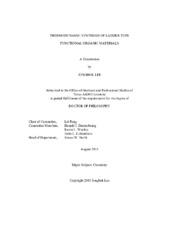| dc.description.abstract | Conjugated ladder-type macromolecules with coplanar, sp2 atom-rich backbones represent a captivating class of materials on account of their well-defined rigid structures, intriguing syntheses, and promising potential in optoelectronic applications. The ladder-type backbones possess an intrinsically rigid conformation and limit possible torsional disorder. The unique architecture of conjugated ladder-type material leads to extended π-conjugation length, longer exciton diffusion length, and enhanced stability. In contrast, conventional conjugated polymers have intrinsic torsional disorder which partially break the conjugation pathways of the polymers and could be detrimental to the material properties.
Several preliminary literature examples have demonstrated the synthesis of ladder-type materials. However, it is still challenging to synthesize well-defined ladder polymers with a minimum level of structural defects because of the poor product solubility and limited synthetic methods. In order to overcome these obstacles, a highly efficient synthetic method and a rationally designed structural characteristic that enables solubility need to be accomplished simultaneously.
We envisioned that thermodynamically controlled ring-closing olefin metathesis (RCM) held the promise for a highly efficient and synthesis of conjugated ladder polymers with minimum levels of structural defects due to the strong thermodynamic driving force of aromatization and its reversible nature between starting material and side products. Moreover, the mild reaction conditions allow a wider scope of substrates and excellent
functional group tolerance. This efficient and versatile synthetic strategy successfully afforded various fused polycyclic heteroarenes, a series of extended ladder-type oligomers, and conjugated ladder polymers with minimum levels of structural defects in excellent yields. Furthermore, RCM demonstrated an excellent ring annulation efficiency with electron deficient acceptor units. Due to the good solubility of the ladder-type materials originating from orthogonally adopted α-branched solubilizing group, the properties of the desired materials were rigorously investigated in solution and the solid-state, such as photophysical properties, solid-state conformation and morphology, effective conjugation length, formation of charge transfer complexes, and crystallization dynamics. This research provides a well-established synthetic strategy to construct a fully conjugated ladder-type material and a fundamental understanding of ladder-type functional organic materials for potential future applications in electronic and optoelectronic devices. | en |


